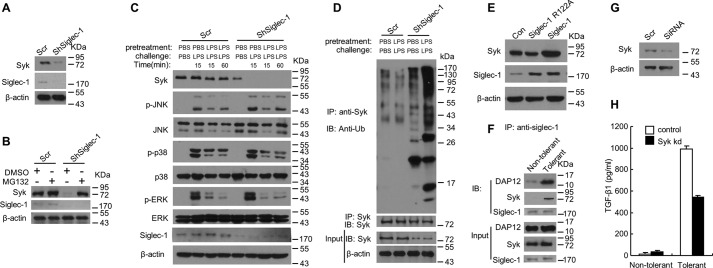FIGURE 7.
Knockdown of siglec-1 reduces Syk protein levels and enhances ubiquitination of Syk in RAW 264.7 cells. A, immunoblot analysis was performed to measure Syk protein in RAW 264.7 cell clones stably overexpressing ShRNA for Siglec-1. B, Siglec-1 knockdown RAW 264.7 cells or scrambled controls were treated with 5 μm MG132 for 24 h. Cell lysates were made and immunoblotted with anti-Syk, anti-Siglec-1, and anti-β-actin antibodies. C, immunoblot analysis of the indicated molecules in lysates of RAW 264.7 cell clones stably overexpressing ShRNA for Siglec-1 stimulated with LPS or pretreated and challenged with LPS for the indicated time. D, silencing of Siglec-1 in RAW 264.7 cells enhances ubiquitination of Sky. RAW 264.7 cell clones stably overexpressing ShRNA for Siglec-1 were tolerized for 24 h with 100 ng/ml LPS, washed three times with PBS, and then challenged for 24 h with 1 μg/ml LPS. Cell lysates were made and immunoprecipitation was performed with anti-Syk antibodies and immunoblotted for ubiquitin. E, immunoblot analysis was performed to measure Syk protein in RAW 264.7 cell clones stably overexpressing Siglec-1. F, Siglec-1, DAP12 and Syk form a complex after induction of endotoxin tolerance. RAW 264.7 cells were tolerized for 24 h with 100 ng/ml LPS, washed three times with PBS, and then challenged for 24 h with 1 μg/ml LPS. Cell lysates were made and immunoprecipitation was performed with anti-Siglec-1 antibodies and immunoblotted for DAP12 and Syk. G and H, introduction of siRNA for Syk to Raw 264.7 cells significantly reduced the protein level of Syk and this led to suppression of TGF-β1 production. The siRNA was transfected into cells with FuGENE 6. After 24 h, the cells were pretreated for 24 h with PBS or 100 ng/ml LPS, washed three times with PBS, and challenged for 24 h with PBS or 1 μg/ml LPS. Immunoblot analysis was performed to measure Syk protein expression (G). TGF-β1 in the cell culture supernatants was assessed by ELISA (H). Data presented in this figure have been reproduced two times.

